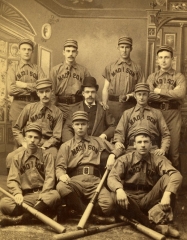“tunk,”
which means a masculine social occasion, often in the evening, at which food and non-alcoholic drinks were served. The earliest reference found, which is in 1882, suggests that the word had been in use for some time. It might have been derived from a term in early Welsh history meaning “food-rent.”
The second was “bum,”
such as “sugar bum”
or “cider bum,”
which were excursions by sleigh, carriage or on foot, to a farmer’s home where warm maple sugar, or maple syrup, and biscuits would be served in the spring or to a cider mill for draughts of fresh apple juice in the autumn. Also, as early as 1882 students took a “run”
, i.e., dismissed themselves, when a professor was late or absent from his class, and would “bohn,”
or study, on occasion.The latter term originated with Bohn’s Classical Library which contained reprints of authors studied in Greek and Latin courses.
College spirit and especially class unity, students felt, were promoted by the cane and salt rushes. Also since the class seldom exceeded 30 the members could know each other quite intimately and often enjoyed seeking amusement as a group. Their sugar and cider bums and banquets, supplemented sometimes by a literary program, helped to reduce the monotony of the long winter months. The Class of 1887, after their last examination in the spring, instituted Senior Pipe Day, somewhat in imitation of practices on other campuses. Seated in a circle out-of-doors, with a large can of lemonade in the center, they smoked and passed around a large Indian pipe and then each smoked his own pipe, meanwhile tasting and drinking the lemonade. To conclude their ceremony, they all joined hands around a grave in which they buried a hatchet and promised to forget all animosities which had grown up among them the past four years.
Individual leisure time activities included long walks, hunting and fishing, chess, and sometimes card playing, an amusement the “authorities”
frowned on, though perhaps less seriously than in an earlier day. Village and faculty homes were often open to students and there were occasionally social clubs in the village where students could meet the local young people and the Hamilton Female Seminary girls. Professor and Mrs. Myron M. Goodenough who maintained the Hamilton Female Seminary arranged for formal social and literary occasions to which they regularly invited large numbers of students.
Celebrating Washington’s Birthday with a literary entertainment, a practice begun in 1867, the juniors perpetuated until 1890. The







